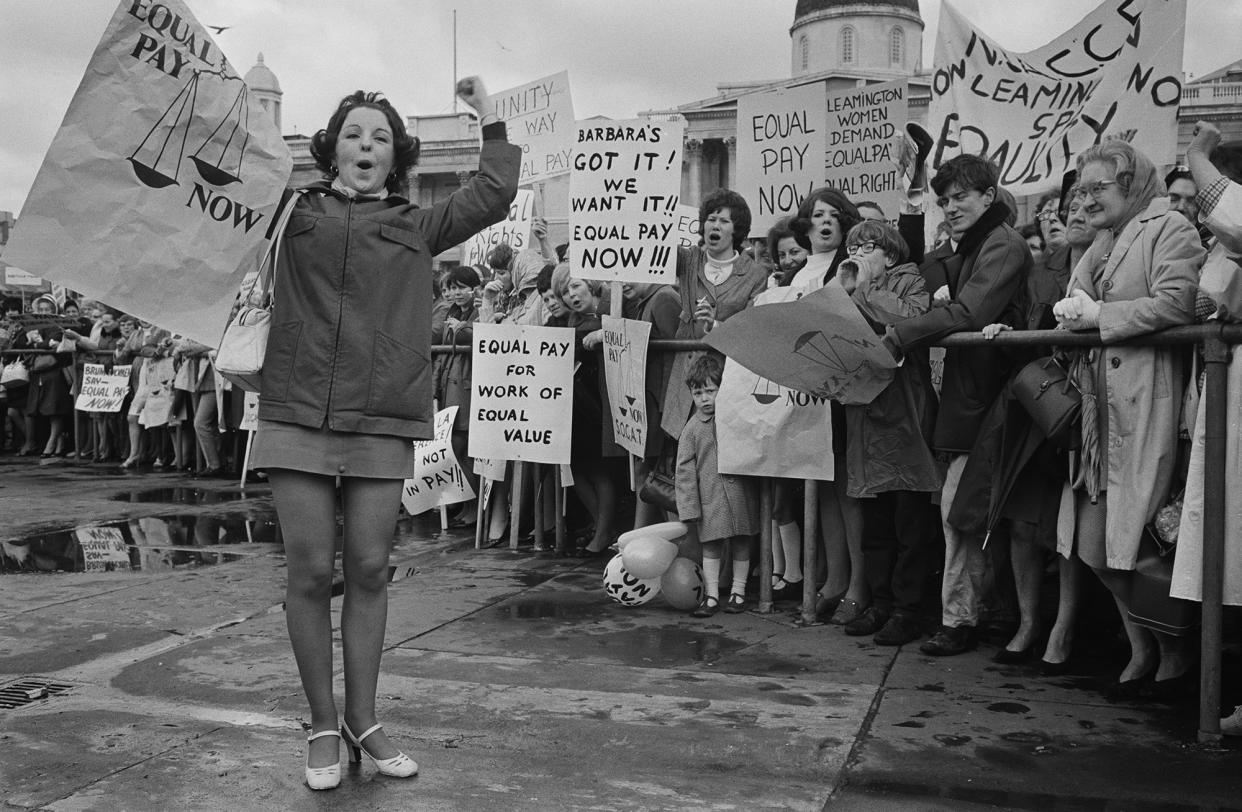5 companies that have closed the gender pay gap

Equal Pay Day is more than a hashtag—it’s a movement. Conceptualized by the National Committee on Pay Equity in 1996, the day was initially created as an awareness event, meant to “symbolize how far into the year women must work to earn what men earned in the previous year.” But with heightened awareness about how much men’s salaries outpace women’s (thanks, Internet), #EqualPayDay has gone from a spotlight on inequality to a rallying cry for change.
It’s change that’s long overdue.
Based on current research from the Institute for Women’s Policy Research (IWPR), women earn less than men in nearly every industry, even when doing equivalent work. This “wage gap,” as it’s come to be known, manifests as women bringing home (on average) 78.3 cents for every dollar that a white man (the highest paid individuals) makes. The number gets even worse when divided up by race. While white women earn roughly 83 centers for every dollar a white man makes, black women take in just 66 cents for every dollar, and hispanic women only 60.
When IWPR released these numbers in 2014, they estimated that the earliest the wage gape would be closed was 2059. It’s this number that inspired executives at activewear brand Lululemon to take action. “That troubled us,” Celeste Burgoyne, Lululemon’s Executive Vice President for the Americas told MAKERS (for whom she serves as a board member). “We value women in an extreme way.”
So last March, in an email to staff, Burgoyne and other leaders at the company pledged to close the pay gap at their own company, within a year. Now, in celebration of #EqualPayDay, Burgoyne has announced that equity has in fact been reached. As of April 2, 100 percent of the 14,000 employees at Lululemon are paid equally for equal work, no matter their gender.
At lululemon, we stand for pay equity. Read more about our journey to close the gender pay gap with @MAKERSwomen: https://t.co/ll1IubtztL #Equalpayday
— lululemon (@lululemon) April 10, 2018
Lululemon, while commendable, isn’t the first to achieve pay equality. In the last few years, multiple companies have come forward to say they’ve achieved pay parity. In support of more companies following their lead, here’s a breakdown of how they did it—and what they had to say afterwards.
Salesforce
Salesforce, a cloud computing company that helps companies streamline their workflow, has regularly been voted one of the best companies to work for. So it’s no wonder that the San Francisco-based company was one of the first to take the lead on this issue. In 2015, the company’s CEO Mark Bernioff called for a review of the salaries of all 16,000 of his employees. When he found a major wage gap between men and women, he spent $3 million to close it. Speaking at the World Economic Forum last year, Bernioff urged his peers to follow suit. “Every CEO needs to look at if they’re paying men and woman the same,” he said. “That is something that every single CEO can do today,”
Apple
Another group that tackled this problem head on was Apple. In August 2016, the company announced that it had closed the wage gap, both among women and people of color. Under a section titled “Pay equity is the right thing to do,” the company highlights its efforts. “We’ve achieved pay equity in every country where we operate when you factor in similar roles, markets and performance,” the statement reads. “Women earn one dollar for every dollar male employees earn. And underrepresented minorities earn one dollar for every dollar white employees earn.” On top of closing the gap, the company said it “examines the compensation” employees earn yearly, and “makes adjustments” to ensure equity is maintained.
Adobe
In 2017, Adobe joined it’s tech neighbors Apple and Intel (which, after careful analysis, found it didn’t have a wage gap), by announcing that its pay disparity had been closed. With women making 99 percent for every dollar men were making, the computer software company didn’t have far to go. But closing that gap was still notable, especially given the companies reach. “We were already close to pay parity in the U.S. through our strong people practices, and now we are proud to have achieved and documented this last step of full parity,” Donna Morris, Adobe’s executive vice president of Customer & Employee Experience said in a statement. “It means a lot to our U.S. employees, and we’re excited to extend that same commitment to our global employee base in the upcoming year.”
Starbucks
We believe in equal pay for equal work.
We’ve achieved 100% pay equity in the US.
We’re committed to making this true globally. #EqualPayDay pic.twitter.com/DUZYjwvoaV— Starbucks Coffee (@Starbucks) April 10, 2018
On March 21, during its annual meeting with shareholders, coffee behemoth Starbucks announced that it had reached pay equality for its more than 200,000 employees nationwide. In a statement on the company’s website, executive vice president and chief partner officer Lucy Helm said the company will continue to fight for pay equity among its partner companies as well. “This milestone is the result of years of work and commitment, and we believe it is important, as a company of our scale, to help bring more attention to this critical issue,” Helm said. “Starbucks has consistently outperformed our industry in terms of pay equity, but it is incumbent upon us to do more.”
Read more from Yahoo Lifestyle:
Single mother of 5 proudly poses with children in law school graduation photos: ‘We did it’
Kylie Minogue says having cancer means she’ll go through menopause twice
Follow us on Instagram, Facebook, and Twitter for nonstop inspiration delivered fresh to your feed, every day.
